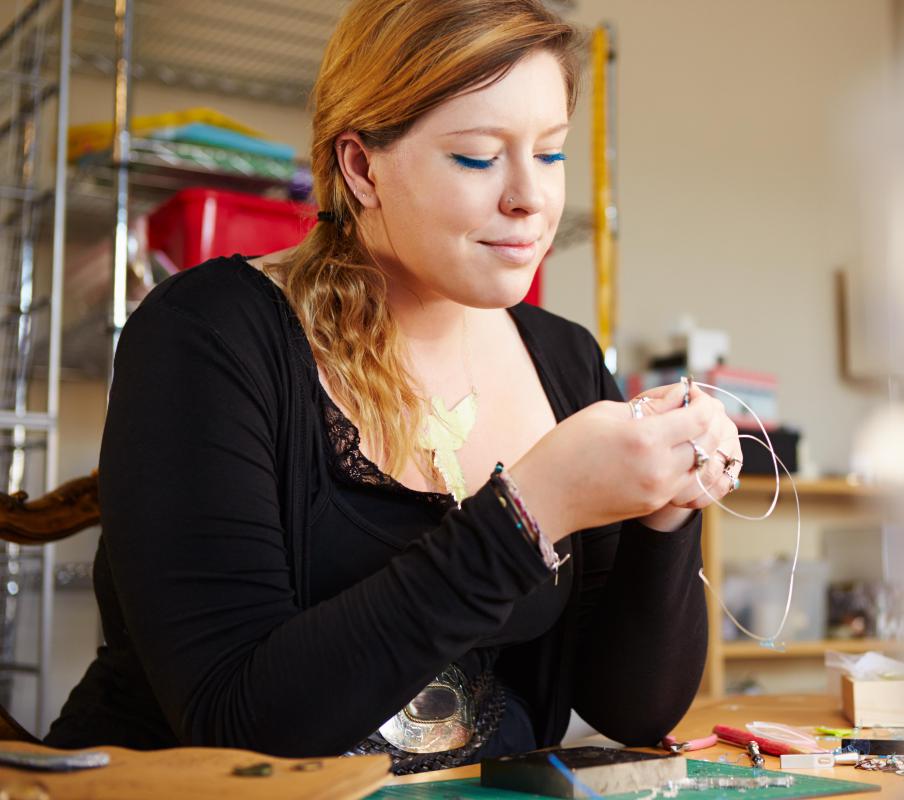At AllThingsNature, we're committed to delivering accurate, trustworthy information. Our expert-authored content is rigorously fact-checked and sourced from credible authorities. Discover how we uphold the highest standards in providing you with reliable knowledge.
What Are the Different Uses for Rattlesnake Skin?
Rattlesnake skin is sometimes used for clothing and accessories. Boots, hats, and purses are sometimes made from the skins of these reptiles, for instance. The end of this snake's tail, known as the rattle, is also used by some jewelry makers and musicians. Rattlesnakes are typically farmed for their skins and meat, especially in certain parts of North and South America. After the skin is removed, it is typically cleaned and tanned before being used.
Boots, particularly cowboy boots, are sometimes made from rattlesnake skin. They are considered both exotic and beautiful. A hefty price tag will usually accompany genuine snake skin boots, though.

Rattlesnake skins may also be used to create hats. Some cowboy hats may be created completely from rattlesnake skin. Others may just have a hat band made from a strip of rattlesnake skin. This snake skin can be used to adorn other types of hats as well, such as fedoras or baseball hats.
Fashionable accessories may also be made from rattlesnake skin. Belts, for instance, may be made from this animal's skin. One large rattlesnake will usually have enough skin for a single wide belt. If the snake is large enough, it may be used to produce two skinnier belts.

Purses and wallets may also be made from rattlesnake skin. One snake may be used to create a couple wallets, but a few snakes are usually needed to make a rattlesnake skin purse. A snake skin briefcase or suitcase also usually requires several rattlesnake skins.
Rattlesnake rattles, which are made from keratin, are also used for some things. Rattles are sometimes used to make jewelry, for instance, such as earrings. Some informal country musicians also use the rattles as musical instruments.
These venomous snakes are indigenous to many parts of the Americas, including Canada, the United States, and Mexico. Most of the rattlesnake skins used for creating the items listed above are obtained from rattlesnake farms. These farms also collect meat and venom, which is used to make rattlesnake anti-venom. Rattlesnake collection is usually safest during the cold winter months, but it is also done during the summer, during mating season.
Before skinning a rattlesnake, many individuals choose to remove the head and rattle. The belly of the snake is then slit from the anal opening to where the head was detached. Skin around the tail of the snake is then loosened with a sharp knife. The loose skin is grasped firmly, and it can be pulled off the rest of the body.
Frequently Asked Questions
What are the traditional uses of rattlesnake skin?
Traditionally, rattlesnake skin has been prized for its unique pattern and durability, making it a popular material for crafting boots, belts, wallets, and other fashion accessories. Its distinctive appearance has also led to its use in decorative items and as a symbol in various cultural artifacts.
Is rattlesnake skin used in any modern industries?
Yes, the modern fashion industry continues to utilize rattlesnake skin for high-end luxury items. Designers often incorporate it into specialty clothing lines and accessories due to its exotic appeal. Additionally, the music industry has seen rattlesnake skin used on the surfaces of some percussion instruments to produce a unique sound.
How is rattlesnake skin harvested and processed for use?
Rattlesnake skin is typically harvested from snakes that are legally hunted or farmed for this purpose. The skin is then carefully removed, treated, and tanned to preserve its natural color and pattern. This process enhances its durability and prepares it for various manufacturing processes.
Are there any ethical concerns regarding the use of rattlesnake skin?
There are ethical concerns surrounding the use of rattlesnake skin, particularly regarding sustainability and animal welfare. Conservationists emphasize the importance of ensuring that rattlesnake populations are not endangered by overhunting. Ethical sourcing and adherence to wildlife protection regulations are crucial in addressing these concerns.
Can rattlesnake skin be used for medicinal purposes?
While there is no scientific evidence to support the medicinal use of rattlesnake skin, some traditional practices attribute healing properties to it. However, these claims are not backed by modern medicine, and the use of rattlesnake skin for medicinal purposes is largely considered a part of folklore.
What makes rattlesnake skin a unique material compared to other animal skins?
Rattlesnake skin is distinct due to its intricate, naturally occurring diamond-shaped patterns and the presence of keratinized scales. This gives it a unique texture and visual appeal that is hard to replicate with other animal skins. Its rarity and the challenge of processing also contribute to its uniqueness and value.
AS FEATURED ON:
AS FEATURED ON:












Discuss this Article
Post your comments